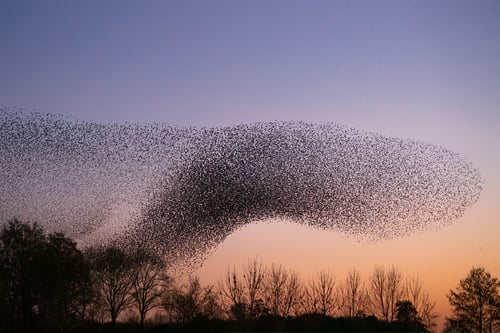You’ve probably heard the saying, “the early bird gets the worm”, commonly used to reference people with an affinity for morning productivity. The phrase originates from our feathered neighbors who are often most active in the early hours of the morning, hungry after a good night's sleep. However, as the seasons change, so do the birds’ habits as they prepare for great migrations. Approaching fall and spring, birds adopt more “night owl” tendencies as they migrate across the dark sky. In fact, this shift is starting to occur right now!
The advantages of night migrations are numerous. Most hawks and other raptor species hunt during the day, using strong thermal updrafts created by the heat of the sun to soar miles into the sky. Night migration provides smaller songbirds such as sparrows, warblers, thrushes, buntings and orioles, security from sharp-taloned threats. Furthermore, the absence of the sun at night keeps birds from overheating and results in a more stable atmosphere that allows for smoother flight. Additionally, and perhaps most importantly, the presence of the stars allows birds to orient themselves in the night sky with ease.

Flock of starlings migrating in the evening hours of the day.
Today, however, their reliance on the stars is placing birds in ever greater peril due to the expansion of human populations across vast landscapes. In particular, the rapid growth of artificial light at night (ALAN) poses a severe threat to bird migrations. A recent study shows that roughly 83% of the world’s population lives under artificially lit skies. This percentage increases to 99% when exclusively considering North America and Europe. The extent of our artificial light production in outdoor spaces is so severe that close to 14% of the global population doesn’t even use their night-time vision! These percentages are only expected to increase over time. Between the years 2012 and 2016, outdoor spaces that were artificially lit at night increased by a rate of about 2% each year.
The growth of ALAN is increasingly fatal for night-time migratory birds. ALAN can often be a disorienting aspect of the night-time landscape for birds as it obscures the brightness of stars and has been found to attract birds, often resulting in their collision with the source of light. A study published in 2014 estimated that anywhere between 365 and 988 million birds are killed annually in the United States by building collisions. Even if birds don’t collide with buildings, the disorientation and confusion resulting from sources of ALAN can leave birds exhausted and resource deprived and more susceptible to other urban threats including cats, cars, and poachers.
Can any measures be taken to reduce our effect on night-time migratory birds traveling through Colorado this fall? The answer is yes! While turning off all lights at night in urban areas isn’t a feasible solution, practical measures such as reducing our individual residential outdoor lighting sources or even sending letters to building managers and elected officials can make a big difference. Furthermore, larger initiatives such as the Fatal Light Awareness Program (FLAP) based in Canada and numerous Lights Out programs organized by the Audubon Society and partners across the United States have outlined strategies for individuals and businesses to help reduce evening light pollution.
We can all play a part in reducing our impact on bird migrations this fall. From turning off outdoor lights to researching movements in your area, there are various ways to affect change. Raising awareness of the plight of "night owl" migratory birds will ultimately lead to a world where human spaces exist in harmony with the amazing habits of birds across the globe.
Kean Kearney is a naturalist at Walking Mountains Science Center who considers himself an avid birder and fellow “night owl” himself. The combination of those two isn’t great for sleep but his love of birds persists.







